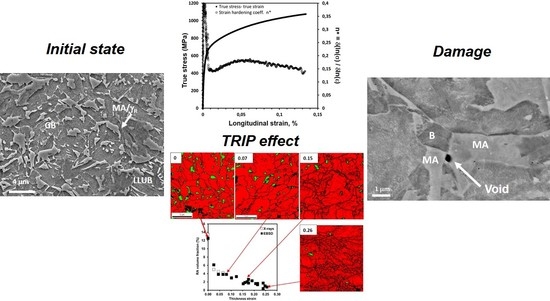Substructure Development and Damage Initiation in a Carbide-Free Bainitic Steel upon Tensile Test
Abstract
:1. Introduction
2. Experimental Section
2.1. Tensile Test
- The width of the specimen was optically measured after every strain.
- The measurement of the thickness was ruled out since thickness observations are not compatible with, on the one hand, the EBSD preparation and, on the other hand, the tracking of a selected zone (typically by a grid of indentations) during uniform deformation due to limitations inherent to the geometry of the tensile specimen.
- The longitudinal strain, measured through the lengthening with the extensometer, is not readily measurable once the necking phenomenon takes place. The printing of a grid (by a square net of low weight indentations) on the sample surface from the initial material was the other option, but it has been dismissed. Two reasons are behind this decision. The surface roughening is expected with strain, and extra preparation would be necessary for further EBSD analysis. This may remove the grid. The second reason is that the grid itself could be a set of points on which strain can accumulate, leading to biasing results.
- It is possible to correlate the relationship between initial (w0 = 2.5 mm) and current width (w) with the initial (t0 = 1 mm) and current thickness (t) after every test interruption. According to [18], if the strain hardening exponent (n) is known, as well as the thickness and width relation, it is feasible to get this relationship; see Figure 1, obtained from data extracted from [18] after some linear extrapolation. In the present work, w0/t0 = 2.5 and the n ≅ 0.16.
- Thus, with the help of the latter work and using the equation , the thickness strain would be directly determined throughout the test irrespective of the stage: Uniform or necking.
- The output strain will thus be the thickness plastic strain.
2.2. Microstructural Characterization
- A detailed analysis of the retained austenite evolution with the strain for the low strain region (below 0.13 longitudinal strain). A fixed region of about 25 × 25 μm2 was selected and scanned to follow its evolution in the first stages of deformation. Four indentations in the gauge length were arranged in a square to track the region of interest. The step size was set at 100 nm.
- The evolution of the microstructure across the necking region. Areas of about 25 × 25 μm2 with a step size of 100 nm were run every 200 μm in the longitudinal direction.
3. Results and Discussion
3.1. Uniform Strain Region
- The retained austenite partially bounded by non-indexed regions, which correspond to martensitic phases, seem to exhibit a poor stability with the strain. This is evident in the regions that are indicated with the red arrows. The distinctly different mechanical behavior of the phases in these microstructures has been put forward through nanohardness measurements [8]. The high-carbon martensite and auto-tempered low-carbon martensite display the highest nanohardness, whereas bainite is the softest phase. In addition, the stability is lower for the retained austenite located between two bainitic packets, indicated by the yellow arrows. Thus, in either case, the stress triaxiality is enhanced due to the mechanical contrast arising from the surroundings. This mechanical contrast is a consequence of either the difference in crystal orientation of adjacent bainitic packets against externally applied stresses [28] or to an even more pronounced variation of the mechanical behavior between bainite and (high-carbon) martensitic-type phases.
- The austenitic islands that are surrounded only by bainite within the same bainitic packet (see blue arrows in Figure 4c,d) have a greater capability to accumulate deformation without any apparent transformation to martensite. In contrast to the case above, the bainite that embeds the austenite islands now has almost the same orientation. This greater stability against transformation has also been observed in austenite embedded in large ferrite grains in TRIP steels [29].
3.2. Necking Region
4. Conclusions
- In the uniform deformation region, the TRIP effect is active for low strains (below 0.05 thickness strain), giving rise to a decrease in the fraction of retained austenite from about 14% to 4%. The transformation almost halts, leading to a stable region in which retained austenite deforms plastically. Finally, in the necking region, the strain-induced martensitic transformation resumes, and less than 1% of austenite is measured for 0.26 thickness strain with conventional EBSD.
- From the morphological point of view, a significant number of large blocky austenite grains is stable in the uniform deformation region. These retained austenite grains exhibit a great ability to develop orientation gradients at the local scale, with lengths of less than 200 nm. Apparently, the RA grains fully surrounded by the bainite with similar crystal orientation present a higher stability than when they are located between bainitic packets with different orientations or adjacent to another harder secondary phase. This has been partially attributed to the local stress triaxiality conditions during tensile tests.
- The onset of the void formation is closely related to the interfaces between bainite and MA phase. The fast drop in RA associated with blocky type morphologies makes the interfaces of transformed RA and the bainitic matrix suitable locations for the onset of the void generation. The fragmentation of blocky MA appears in a later stage of strain as a new mode for void formation. At this point, the ability of the bainitic matrix to create high angle boundaries around voids plays a relevant role in the control of their growth and eventual coalescence.
- The morphology of the MA phase influences its fracture. In order to improve the cold formability of the TRIP-aided bainitic steels, the number of MA islands associated with previous austenite grain boundaries should be eliminated or at least minimized.
Author Contributions
Funding
Acknowledgments
Conflicts of Interest
Appendix A
- Firstly, the maximum KAM (kernel average misorientation) value is fixed. Typically, this value is set at 5° or 10°.
- Then, the mean KAM value at various distances is measured for the phase of interest at each point. In Figure A1, first and second neighbors are represented. After the calculation of KAM1st (Pij), it is averaged for each strain condition (ε) as detailed KAM1st (ε). Their related distances are also included in the figure (D1st and D2nd).
- Then, a linear regression is obtained from the data (see plot at the bottom of Figure A1) and the slope is the value of the local orientation gradient for each strain condition.

References
- Efthymiadis, P.; Hazra, S.; Clough, A.; Lakshmi, R.; Alamoudi, A.; Dashwood, R.; Shollock, B. Revealing the mechanical and microstructural performance of multiphase steels during tensile, forming and flanging operations. Mat. Sci. Eng. A 2017, 701, 174–186. [Google Scholar] [CrossRef]
- Jimenez-Melero, E.; van Dijk, N.H.; Zhao, L.; Sietsma, J.; Offerman, S.E.; Wright, J.P.; van der Zwaag, S. Characterization of individual retained austenite grains and their stability in low-alloyed TRIP steels. Acta Mater. 2007, 55, 6713–6723. [Google Scholar] [CrossRef]
- Fonstein, N. Advanced High Strength Steels: Physical Metallurgy, Design, Processing and Properties, 1st ed.; Springer International Publishing: Cham, Switzerland, 2015. [Google Scholar]
- Speer, J.G.; De Moor, E.; Clarke, A.J. Critical Assessment 7: Quenching and Partitioning. Mat. Sci. Tech. 2015, 31, 3–9. [Google Scholar] [CrossRef]
- Speer, J.G.; De Moor, E.; Findley, K.O.; Matlock, D.K.; De Cooman, B.C.; Edmonds, D.V. Analysis of microstructure evolution in quenching and partitioning automotive sheet steel. Metall. Mat. Trans. A 2011, 42, 3591–3601. [Google Scholar] [CrossRef]
- Miyata, M.; Fushiwaki, Y.; Suzuki, Y.; Nagano, H.; Nagataki, Y. Effect of Si/Mn Ratio on Galvannealing Behavior of Si-added Steel. ISIJ Int. 2018, 58, 1600–1607. [Google Scholar] [CrossRef]
- Savran, V.; Galan-Lopez, J.; Hisker, F.; Schreiber, S.; Van Bohemen, S.; Kestens, L.A.I.; Shakerifard, B.; Zhu, K.; Taboada, M.C.; Jorge-Badiola, D.; et al. Baseform: Bainite and second-phase engineering for improved formability. Eur. Com. 2019, in press. [Google Scholar]
- Taboada, M.C.; Elizalde, M.R.; Jorge-Badiola, D. Austempering in low-C steels: Microstructure development and nanohardness characterization. J. Mater. Sci. 2019, 54, 5044–5060. [Google Scholar] [CrossRef]
- Sugimoto, K.; Iuda, T.; Sakaguchi, J.; Kashima, T. Retained Austenite Characteristics and Tensile Properties in a TRIP Type Bainitic Sheet Steel. ISIJ Int. 2000, 40, 902–908. [Google Scholar] [CrossRef]
- Jacques, P.J.; Furnémont, Q.; Lani, F.; Pardoen, T.; Delannay, F. Multiscale mechanics of TRIP-assisted multiphase steels: I. Characterization and mechanical testing. Acta Mater. 2007, 55, 3681–3693. [Google Scholar] [CrossRef]
- Chiang, J.; Lawrence, B.; Boyd, J.D.; Pilkey, A.K. Effect of microstructure on retained austenite stability and work hardening of TRIP steels. Mat. Sci. Eng. A 2011, 528, 4516–4521. [Google Scholar] [CrossRef]
- Hisker, F.; Thiessen, R.; Heller, T. Influence of Microstructure on Damage in Advanced High Strength Steels. Mater. Sci. Forum 2012, 706–709, 925–930. [Google Scholar] [CrossRef]
- Avramovic-Cingara, G.; Ososkov, Y.; Jain, M.K.; Wilkinson, D.S. Effect of martensite distribution on damage behavior in DP600 dual phase steels. Mat. Sci. Eng. A 2009, 516, 7–16. [Google Scholar] [CrossRef]
- Calcagnotto, M.; Ponge, D.; Adachi, Y.; Raabe, D. Effect of Grain Refinement on Strength and Ductility in Dual-Phase Steels. In Proceedings of the 2nd International Symposium on Steel Science (ISSS 2009), Kyoto, Japan, 21–24 October 2009. [Google Scholar]
- Tasan, C.C.; Hoefnagels, J.P.M.; Diehl, M.; Yan, D.; Roters, F.; Raabe, D. Strain localization and damage in dual phase steels investigated by coupled in-situ deformation experiments and crystal plasticity simulations. Int. J. Plast. 2014, 63, 198–210. [Google Scholar] [CrossRef]
- Jacques, P.; Furnémont, Q.; Pardoen, T.; Delannay, F. On the role of martensitic transformation on damage and cracking resistance in TRIP-assisted multiphase steels. Acta Mater. 2001, 49, 139–152. [Google Scholar] [CrossRef]
- Cai, M.-h.; Ding, H.; Lee, Y.-k.; Tang, Z.-y.; Zhang, J.-s. Effects of Si on Microstructural Evolution and Mechanical Properties of Hot-rolled Ferrite and Bainite Dual-phase Steels. ISIJ Int. 2011, 51, 476–481. [Google Scholar] [CrossRef]
- Choung, J.M.; Cho, S.R. Study on true stress correction from tensile tests. J. Mech. Sci. Tech. 2008, 22, 1039–1051. [Google Scholar] [CrossRef]
- Jarvinnen, M. Texture effect in X-ray analysis of retained austenite in steels. Texture Microstruct. 1996, 26–27, 93–101. [Google Scholar] [CrossRef]
- Ruhl, R.; Cohen, M. Splat quenching of iron–carbon alloys Trans. Metall. Soc. AIME 1969, 245, 241–251. [Google Scholar]
- Zajac, S.; Schwinn, V.; Tacke, K.-H. Characterisation and quantification of complex bainitic microstructures in high and ultra-high strength linepipe steels. Mat. Sci. Forum 2005, 500–501, 387–394. [Google Scholar] [CrossRef]
- García-Mateo, C.; Caballero, F.G.; Chao, J.; Capdevila, C.; García de Andrés, C. Mechanical stability of retained austenite during plastic deformation of super high strength carbide free bainitic Steel. J. Mat. Sci. 2009, 44, 4617–4624. [Google Scholar] [CrossRef]
- Jiang, J.; Britton, T.B.; Wilkinson, A.J. Evolution of dislocation density distributions in copper during tensile deformation. Acta Mater. 2013, 61, 7227–7239. [Google Scholar] [CrossRef]
- Kamaya, M. Assessment of local deformation using EBSD: Quantification of accuracy of measurement and definition of local gradient. Ultramicroscopy 2011, 111, 1189–1199. [Google Scholar] [CrossRef] [PubMed]
- Kamaya, M.; Wilkinson, A.J.; Titchmarsh, J.M. Quantification of plastic strain of stainless steel and nickel alloy by electron backscatter diffraction. Acta Mater. 2006, 54, 539–548. [Google Scholar] [CrossRef]
- He, B.B.; Huang, M.X. On the Mechanical Stability of Austenite Matrix After Martensite Formation in a Medium Mn Steel. Metal. Mater. Trans. A 2016, 47, 3346–3353. [Google Scholar] [CrossRef]
- García-Mateo, C.; Caballero, F.G. The role of retained austenite on tensile properties of steels with bainitic microstructures. Mater. Trans. 2005, 46, 1839–1846. [Google Scholar] [CrossRef]
- Li, W.S.; Gao, H.Y.; Nakashima, H.; Hata, S.; Tian, W.H. In-situ study of the deformation-induced rotation and transformation of retained austenite in a low-carbon steel treated by the quenching and partitioning process. Mat. Sci. Eng. A 2016, 649, 417–425. [Google Scholar] [CrossRef]
- Tirumalasetty, K.; van Huis, M.A.; Kwakernaak, C.; Sietsma, J.; Sloof, W.G.; Zandbergen, H.W. Deformation-induced austenite grain rotation and transformation in TRIP-assisted steel. Acta Mater. 2012, 60, 1311–1321. [Google Scholar] [CrossRef]
- Zaefferer, S.; Romano, P.; Friedel, F. EBSD as a tool to identify and quantify bainite and ferrite in low-alloyed Al-TRIP steels. J. Micros. 2008, 230, 499–508. [Google Scholar] [CrossRef]
- Allain-Bonasso, N.; Wagner, F.; Berbenni, S.; Field, D.P. A study of the heterogeneity of plastic deformation in IF steel by EBSD. Mat. Sci. Eng. A 2012, 548, 56–63. [Google Scholar] [CrossRef]
- Kubin, L.P.; Mortensen, A. Geometrically necessary dislocations and strain-gradient plasticity: A few critical issues. Scr. Mater. 2003, 48, 119–125. [Google Scholar] [CrossRef]
- Zhou, W.; Hou, T.; Zhang, C.; Zhong, L.; Wu, K. Effect of Carbon Content in Retained Austenite on the Dynamic Tensile Behavior of Nanostructured Bainitic Steel. Metals 2018, 8, 907. [Google Scholar] [CrossRef]
- Nakada, N.; Ishibashi, Y.; Tsuchiyama, T.; Takaki, S. Self-stabilization of untransformed austenite by hydrostatic pressure via martensitic transformation. Acta Mater. 2016, 110, 95–102. [Google Scholar] [CrossRef]
- Hasan, S.M.; Mandal, A.; Signh, S.B.; Chakabarti, D. Work hardening behavior and damage mechanisms in carbide free steel during uni-axial tensile deformation. Mat. Sci. Eng. A 2019, 751, 142–153. [Google Scholar] [CrossRef]
- Díaz-Fuentes, M.; Iza-Mendia, A.; Gutiérrez, I. Analysis of different acicular ferrite microstructures in low-carbon steels by electron backscattered diffraction. Study of their toughness behavior. Met. Mater. Trans. A 2003, 34, 2505–2516. [Google Scholar] [CrossRef]
- Norström, L.A. On the yield strength of quenched low-alloy lath martensite. Scand. J. Metall. 1976, 5, 159–165. [Google Scholar]
- Magner, S.H.; de Angleis, R.J.; Weins, W.N.; Makinson, J.D. A historical review of retained austenite and its measurement by X-Ray diffraction. Adv. X-Ray Anal. 2002, 45, 92–97. [Google Scholar]
- Moussa, C.; Bernacki, M.; Besnard, R.; Bozzolo, N. Statistical analysis of dislocations and dislocation boundaries from EBSD data. Ultramicroscopy 2017, 179, 63–72. [Google Scholar] [CrossRef] [Green Version]
- Scheriau, S.; Pippan, R. Influence of grain size on orientation changes during plastic deformation. Mat. Sci. Eng. A 2008, 493, 48–52. [Google Scholar] [CrossRef]
- Allain, S.Y.P.; Bouaziz, O.; Pushkareva, I.; Scott, C.P. Towards the microstructure design of DP steels: A generic size-sensitive mean-field mechanical model. Mat. Sci. Eng. A 2015, 637, 222–234. [Google Scholar] [CrossRef]
- Celotto, S.; Ghadbeigi, H.; Pinna, C.; Shollock, B.A.; Efthymiadis, P. Deformation-Induced Microstructural Banding in TRIP Steels. Met. Mat. Trans. A 2018, 49, 2893–2906. [Google Scholar] [CrossRef] [Green Version]
- Straumal, B.B.; Kucheev, Y.O.; Efron, L.I.; Petelin, A.L.; Dutta Majumdar, J.; Manna, I. Complete and Incomplete Wetting of Ferrite Grain Boundaries by Austenite in the Low-Alloyed Ferritic Steel. J. Mater. Eng. Performance. 2012, 21, 667–670. [Google Scholar] [CrossRef]
- Li, X.; Ma, X.; Subramanian, S.V.; Shang, C.; Misra, R.D.K. Influence of prior austenite grain size on martensite–austenite constituent and toughness in the heat affected zone of 700 MPa high strength linepipe steel. Mat. Sci. Eng. A 2014, 616, 141–147. [Google Scholar] [CrossRef]
- Shakerifard, B.; Galan Lopez, J.; Hisker, F.; Kestens, L.A.I. Crystallographically resolved damage initiation in advanced high strength steel. IOP Conf. Ser. Mater. Sci. Eng. 2018, 375, 1–8. [Google Scholar] [CrossRef]
- Chen, Z.; Youshi, H.; Guochen, L. Characteristics of shear banding in dual phase steel. Mat. Sci. Tech. 1993, 9, 1037–1043. [Google Scholar] [CrossRef]
- Heibel, S.; Dettinger, T.; Nester, W.; Clausmeyer, T.; Erman Tekkaya, A. Damage Mechanisms and Mechanical Properties of High-Strength Multiphase Steels. Materialia 2018, 11, 761. [Google Scholar] [CrossRef] [PubMed] [Green Version]
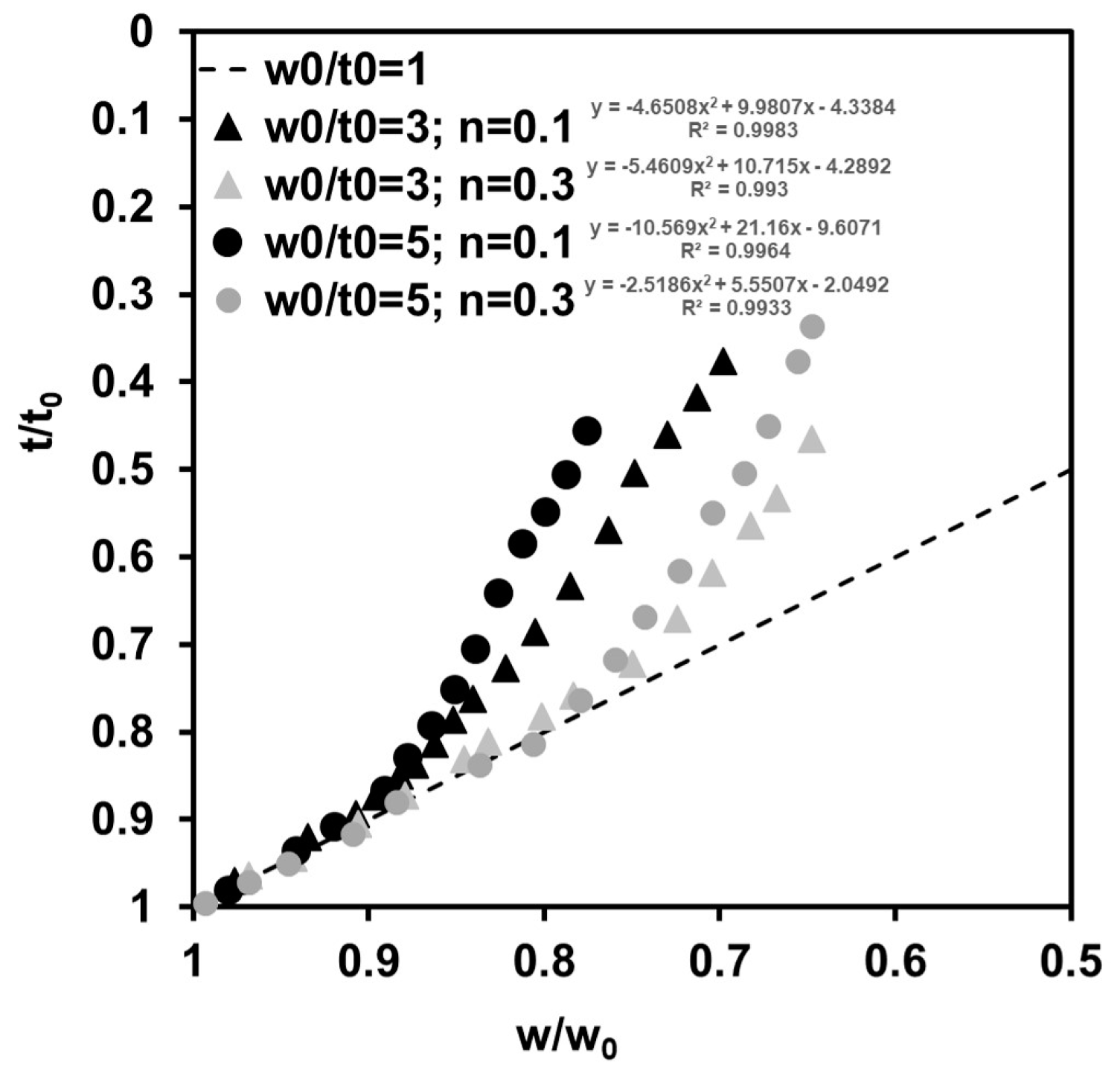
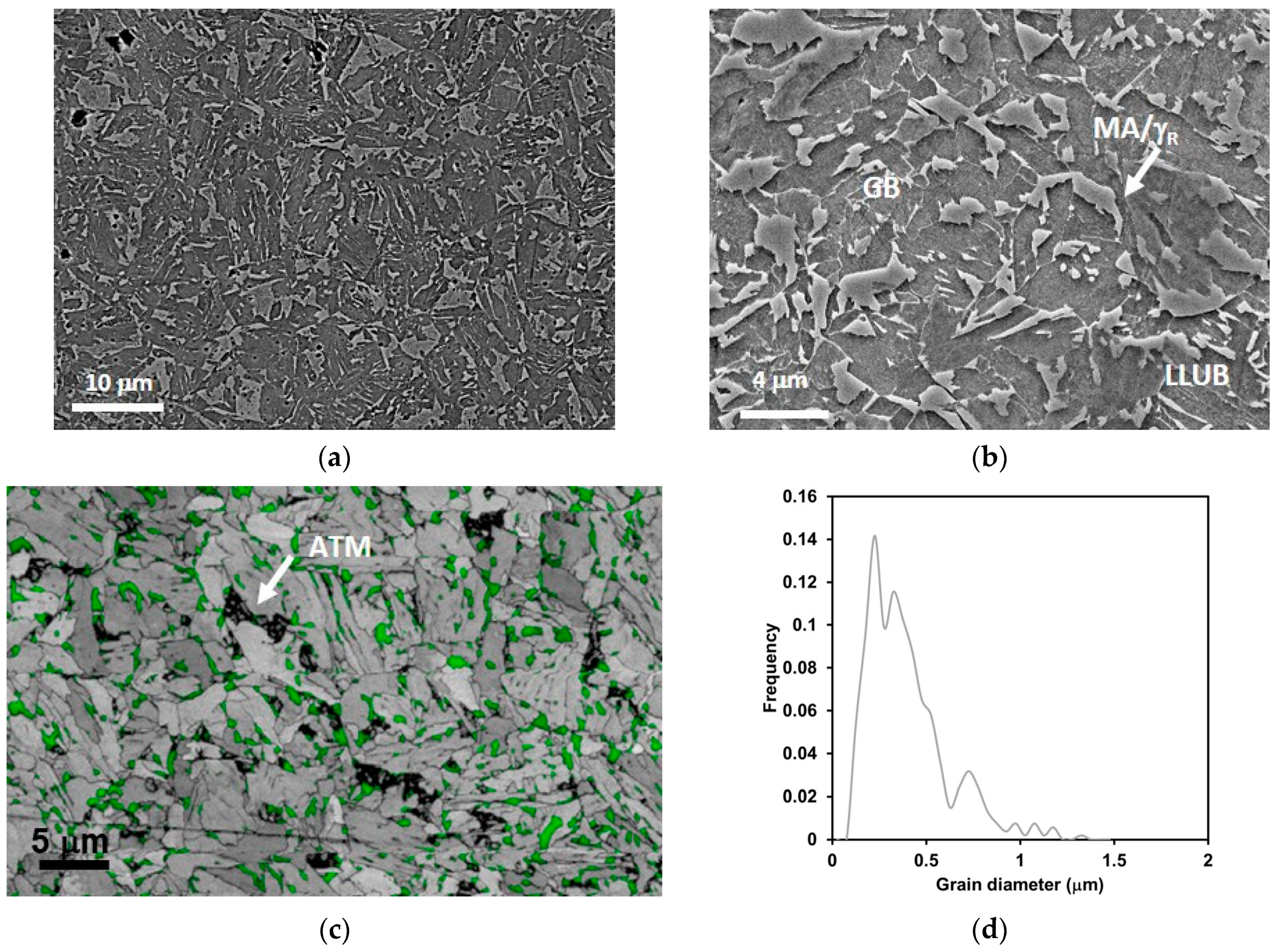


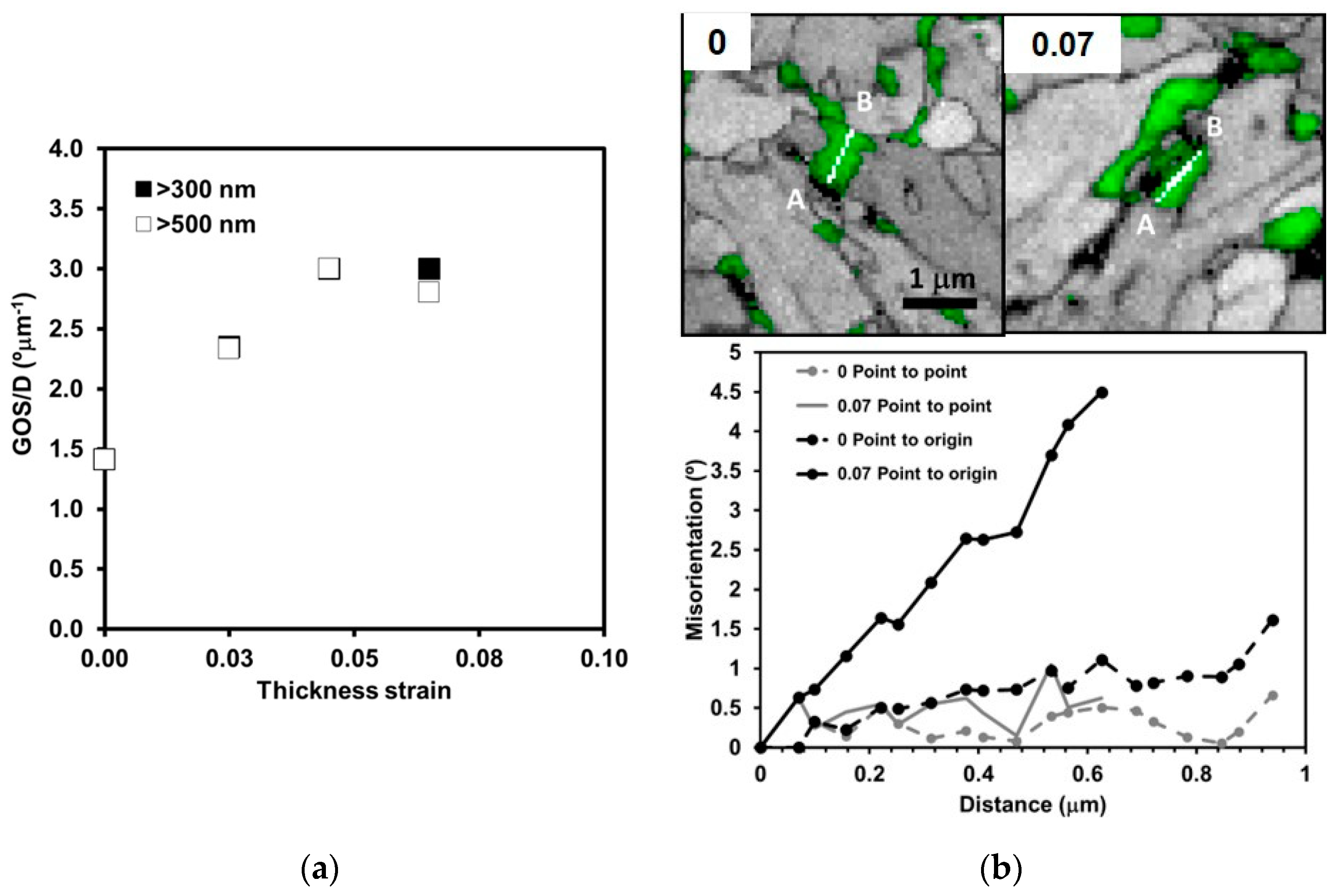
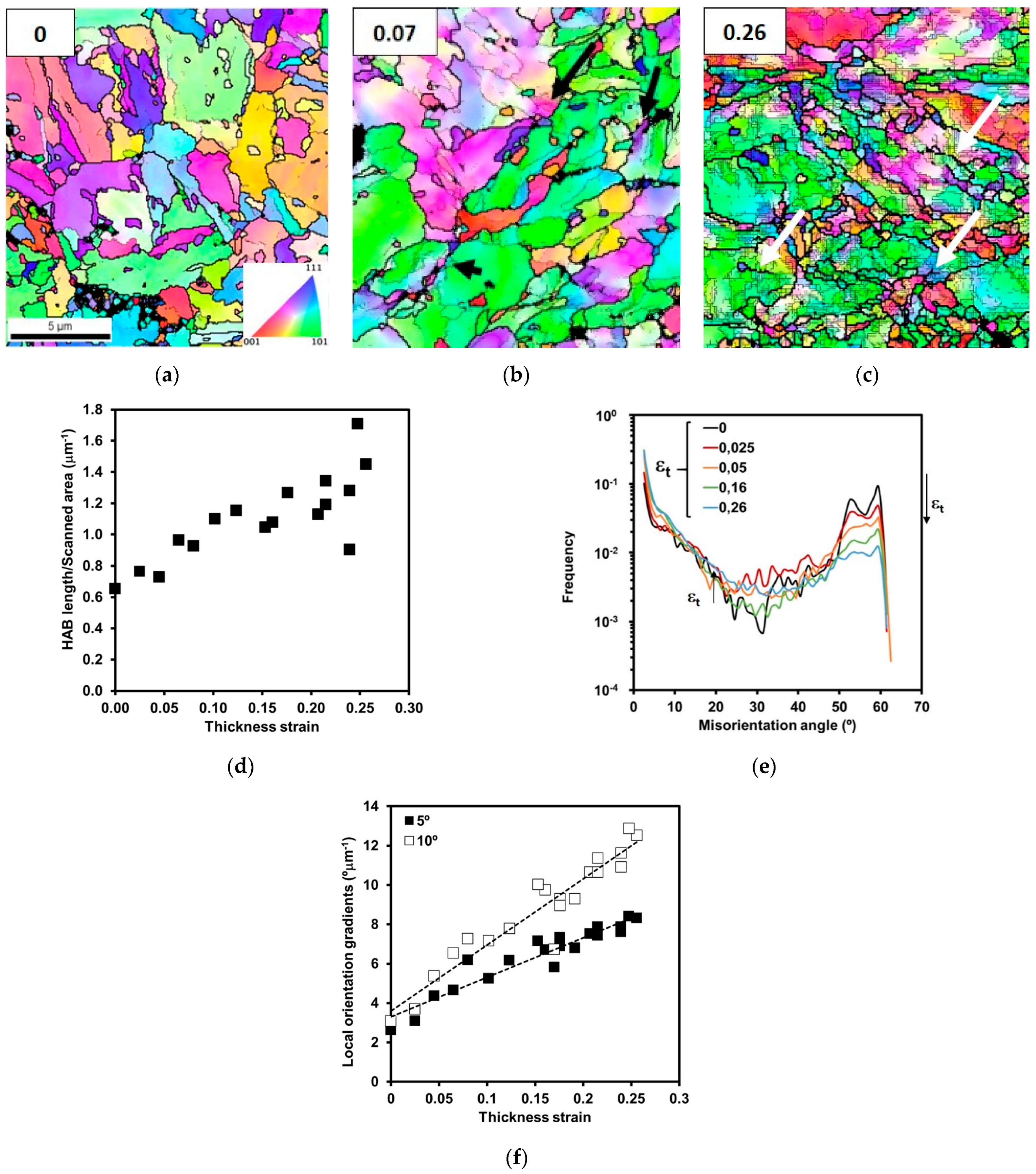

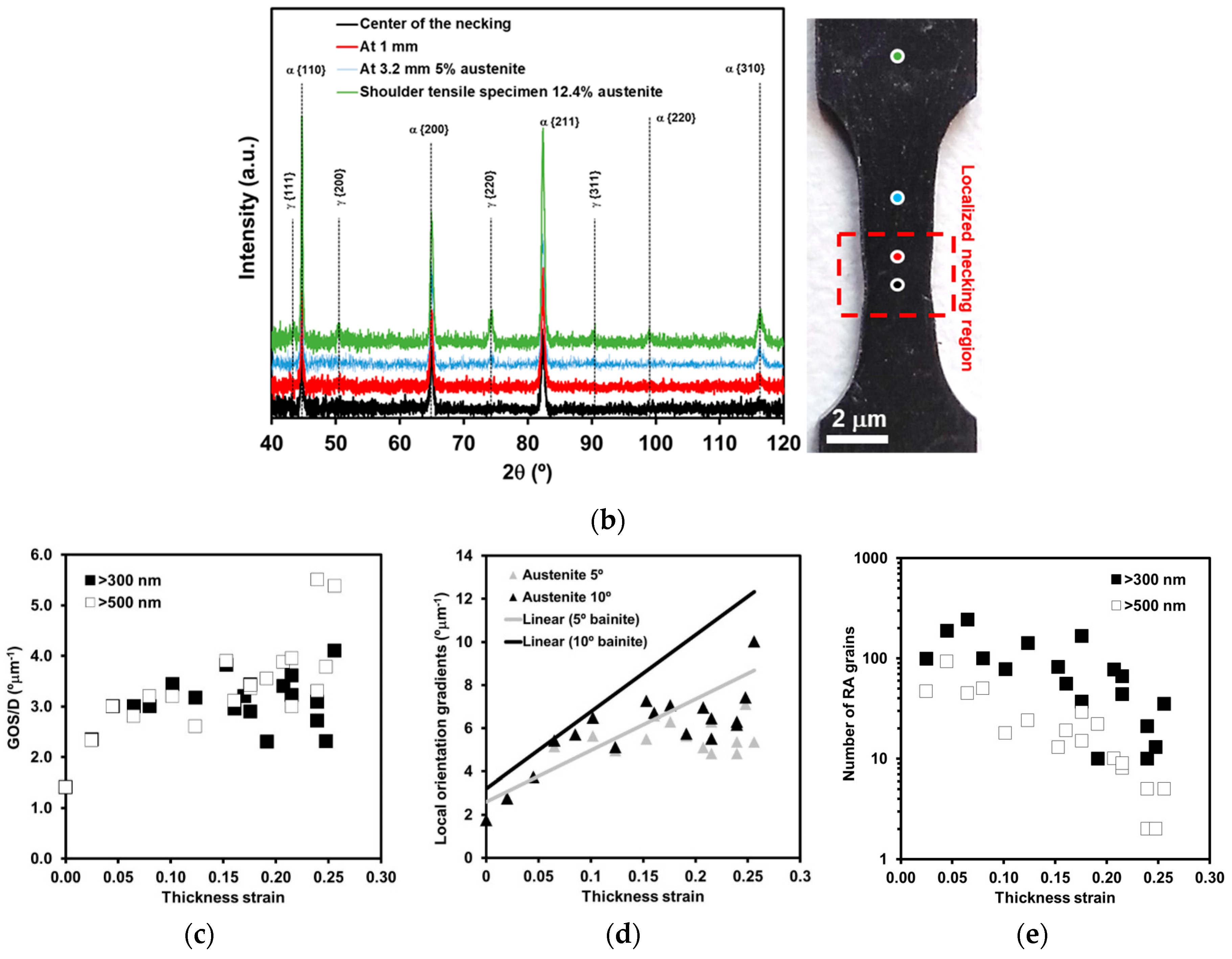

| F2ry (%) by FEG-SEM Imaging | RA (%) by X-Ray | %C in RA by X-Ray |
|---|---|---|
| 18.0 ± 1.5 | 13.4 ± 0.8 | 1.1 ± 0.1 |
| Hardness (HV1) | R0.2% (MPa) | TS Tensile Strength (MPa) | Elongation at Fracture E25 (%) |
|---|---|---|---|
| 348 ± 6 | 659 | 962 | 16.9 |
© 2019 by the authors. Licensee MDPI, Basel, Switzerland. This article is an open access article distributed under the terms and conditions of the Creative Commons Attribution (CC BY) license (http://creativecommons.org/licenses/by/4.0/).
Share and Cite
Taboada, M.C.; Iza-Mendia, A.; Gutiérrez, I.; Jorge-Badiola, D. Substructure Development and Damage Initiation in a Carbide-Free Bainitic Steel upon Tensile Test. Metals 2019, 9, 1261. https://doi.org/10.3390/met9121261
Taboada MC, Iza-Mendia A, Gutiérrez I, Jorge-Badiola D. Substructure Development and Damage Initiation in a Carbide-Free Bainitic Steel upon Tensile Test. Metals. 2019; 9(12):1261. https://doi.org/10.3390/met9121261
Chicago/Turabian StyleTaboada, Mari Carmen, Amaia Iza-Mendia, Isabel Gutiérrez, and Denis Jorge-Badiola. 2019. "Substructure Development and Damage Initiation in a Carbide-Free Bainitic Steel upon Tensile Test" Metals 9, no. 12: 1261. https://doi.org/10.3390/met9121261




